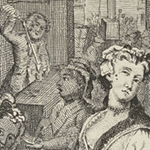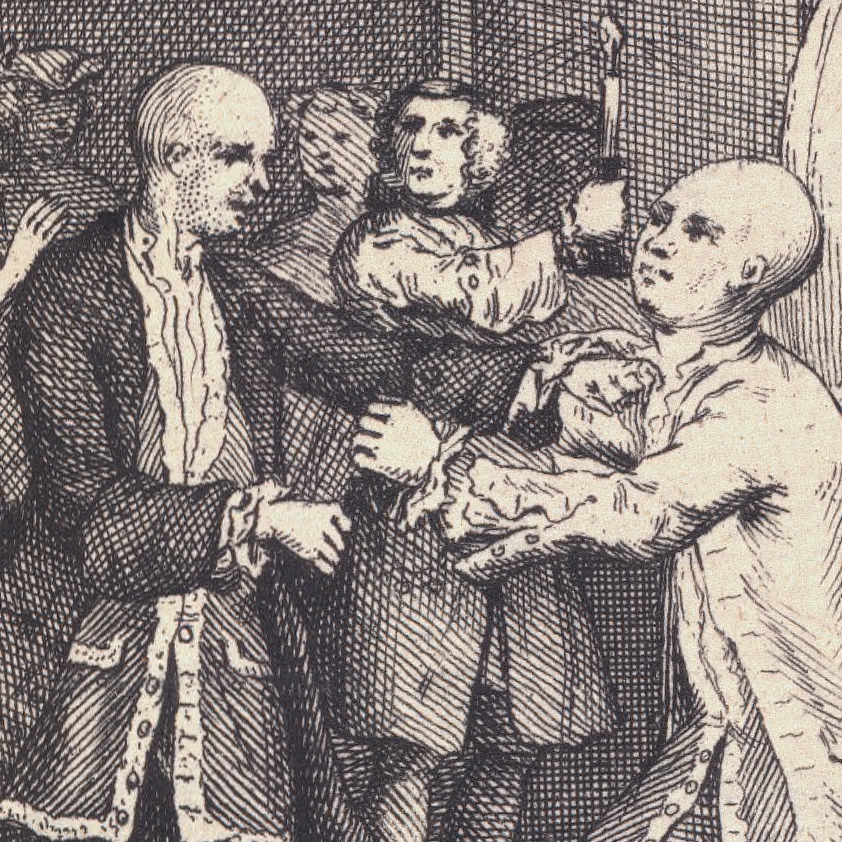King's Coffee House
Names
- Tom King's Coffee House
- Moll King's Coffee House
- King's Coffee House
- Moll's Reception House
- King's College
- Fair Reception Coffee House
Street/Area/District
- Covent Garden
Maps & Views
- 1690 (-1790) Covent Garden (Crowle): Moll & Tom King's Coffee House
- 1736 London (Moll & Bowles): Tom and Moll King's Coffee House
- 1746 London, Westminster & Southwark (Rocque): Moll King's Coffee House, Covent Garden (1728–1747)
Descriptions
from Club Life of London with Anecdotes of the Clubs, Coffee-houses and Taverns of the Metropolis during the 17th, 18th, and 19th Centuries, by John Timbs (1866)
Tom King's Coffee-House.
This was one of the old night-houses of Covent Garden Market: it was a rude shed immediately beneath the portico of St. Paul's Church, and was one "well known to all gentlemen to whom beds are unknown." Fielding in one of his Prologues says:
"What rake is ignorant of King's Coffee-house?"
It is in the background of Hogarth's print of Morning, where the prim maiden lady, walking to church, is soured with seeing two fuddled beaux from King's Coffee-house caressing two frail women. At the door there is a drunken row, in which swords and cudgels are the weapons.
Harwood's Alumni Etonenses, p. 293, in the account of the Boys elected from Eton to King's College, contains this entry: "A.D. 1713, Thomas King, born at West Ashton, in Wiltshire, went away scholar in apprehension that his fellowship would be denied him; and afterwards kept that Coffee-house in Covent Garden, which was called by his own name."
Moll King was landlady after Tom's death: she was witty, and her house was much frequented, though it was little better than a shed. "Noblemen and the first beaux," said Stacie, "after leaving Court, would go to her house in full dress, with swords and bags, and in rich brocaded silk coats, and walked and conversed with persons of every description. She would serve chimney-sweepers, gardeners, and the market-people in common with her lords of the highest rank. Mr. Apreece, a tall thin man in rich dress, was her constant customer. He was called Cadwallader by the frequenters of Moll's." It is not surprising that Moll was often fined for keeping a disorderly house. At length, she retired from business—and the pillory—to Hampstead, where she lived on her ill-earned gains, but paid for a pew in church, and was charitable at appointed seasons, and died in peace in 1747.
It was at that period that Mother Needham, Mother Douglass (alias, according to Foote's Minor, Mother Cole), and Moll King, the tavern-keepers and the gamblers, took possession of premises abdicated by people of fashion. Upon the south side of the market-sheds was the noted "Finish," kept by Mrs. Butler, open all night, the last of the Garden taverns, and only cleared away in 1829. This house was originally the Queen's Head. Shuter was pot-boy here. Here was a picture of the Hazard Club, at the Bedford: it was painted by Hogarth, and filled a panel of the Coffee-room.
Captain Laroon, an amateur painter of the time of Hogarth, who often witnessed the nocturnal revels at Moll King's, made a large and spirited drawing of the interior of her Coffee-house, which was at Strawberry Hill. It was bought for Walpole, by his printer, some seventy years since. There is also an engraving of the same room, in which is introduced a whole-length of Mr. Apreece, in a full court-dress: an impression of this plate is extremely rare.
Justice Welsh used to say that Captain Laroon, his friend Captain Montague, and their constant companion, Little Casey, the Link-boy, were the three most troublesome of all his Bow-street visitors. The portraits of these three heroes are introduced in Boitard's rare print of "the Covent Garden Morning Frolic." Laroon is brandishing an artichoke. C. Montague is seated, drunk, on the top of Bet Careless's sedan, which is preceded by Little Casey, as a link-boy.
Captain Laroon also painted a large folding-screen; the figures were full of broad humour, two representing a Quack Doctor and his Merry Andrew, before the gaping crowd.
Laroon was deputy-chairman, under Sir Robert Walpole, of a Club, consisting of six gentlemen only, who met, at stated times, in the drawing-room of Scott, the marine painter, in Henrietta-street, Covent Garden; and it was unanimously agreed by the members, that they should be attended by Scott's wife only, who was a remarkable witty woman. Laroon made a beautiful conversation drawing of the Club, which is highly prized by J. T. Smith.
from London Past and Present: Its History, Associations, and Traditions, by Henry Benjamin Wheatley and Peter Cunningham (1891)
King's Coffee-house, Covent Garden Market, a common shed immediately beneath the portico of the church, long since swept away, and once "well-known," says Arthur Murphy, "to all gentlemen to whom beds are unknown." It was kept by a person of the name of Tom King, and forms a conspicuous object in Hogarth's print of Morning. Tom King was a native of West Ashton in Wiltshire, and a scholar at Eton, but "went away," 1713, says Harwood, "in apprehension that his fellowship would be denied him, and afterwards kept that coffee-house in Covent Garden which was called by his own name."1
What rake is ignorant of King's Coffee-House.—Fielding, Prologue to the Covent Garden Tragedy, 1732.
from London Coffee Houses, by Bryant Lillywhite (1963)
1370. Tom King's Coffee House, Covent Garden. On the south side of the Market opposite Southampton Street. Is described by Cunningham, Timbs, and others as 'one of the old night-houses of Covent Garden Market; it was a rude shed immediately beneath the portico of St. Paul's Church, and was "well known to all gentlemen to whom beds are unknown".' It was kept by Tom King, a native of West Ashton in Wiltshire,' King had been a scholar at Eton, but in 1715 'went away' says Harwood in Alumni Etonensis 'in apprehension that his fellowship would be denied him'. At his death, the date of which is unknown, his widow Moll King, continued the business.
- 1732
- The earliest contemporary mention appears to be Fielding's Prologue to the Covent Garden Tragedy, 1732: 'What rake is ignorant of King's Coffee-House?' Obviously the house was established earlier.
- 1735
- The customs and manners of a part of the community in 1735 are satirically described in 'A Covent-garden Eclogue' quoted by Malcolm in 'Manners & Customs':
'The watch had cry'd Past One, with hollow strain, And to their stands return'd to sleep again; Grace cits and bullies, rakes and squeamish beaux, Came reeling with their doxies from the Rose; Jephson's and Michell's hurry now was done, And now Tom King's (so rakes ordain'd) begun; Bright shone the Moon, and calm around the sky, No cinder-wench, nor straggling link-boy nigh, When in that garden, where with mimic pow'r Strut the mock-purple heroes of an hour; Where by grave matrons cabbages are sold, Who all the live-long day drink gin and scold ....'
- 1738–41
- Hogarth's drawing 'Morning' published 25 March, 1738, depicts a single storied building against the portico of the church: over the doorway is TOM KINGS COFFEE HOUSE and typical Hogarth characters stand in the foreground. In 1738, was published 'Tom K—s; or the Paphian Grove ...' In 1741, the 'Humours of Covent Garden' shews the exterior of Tom King's with the Sign of a Black-a-moor.
- 1739
- Tom King evidently died before 1739. On 24 May in that year, Moll King Mistress of Tom's Coffee House Covent Garden was brought to the King's Bench to receive judgement, when the Court committed her to the King's Bench Prison Southwark, till they took time to consider of a punishment adequate to the offence of keeping a disorderly house. (de Castro MS.)
Various writers mention Moll King as a queer character. Thompson relates that Moll 'was renowned for her good humour and repartee' and quoting Stacie, says that 'noblemen and the first beaux of the Court would go to her place in full dress with swords and bags and in rich brocaded coats, and walked and conversed with persons of every description ....' She was repeatedly fined for keeping a disorderly house. At length she retired, says Timbs 'from business and to the pillory and to Hampstead' where 'she died in peace in 1747'. - 1747
- Her death took place 17 Sep. 1747 at Haverstock Hill.
It seems the coffee-house continued after Moll King's retirement. - 1748
- Mentioned by Tobias George Smollett (1721–71) in 'Roderick Random' 1748: 'It being now near two o'clock in the morning, we discharged the bill and sallied out into the street. Billy Chaten being unable to speak or stand, was sent to a bagnio and Banter and I accompanied Bragwell to Moll King's Coffee House, where, after he had kicked half a dozen hungry whores, we left him to sleep on a bench and directed our course towards Charing Cross ....'
- c. 1760s
- Chancellor says 'The Finish' succeeded Moll King's tenancy,
- 1779–88
- but de Castro MS in Guildhall Library gives two later references, 1779 Nocturnal Revels a History of Kings, Goadby, I, 8–10; and 1788 Adventures of a Specialist, G.A. Stevens, I, 260, but it does not follow that 'Tom King's' still existed.
The coffee-house probably disappeared before 1795 when St. Paul's Church was 'destroyed by fire'. See Finish, No. 406.
from London Coffee Houses, by Bryant Lillywhite (1963)
1830. Moll King's Coffee House, Covent Garden. Chancellor says 'The Finish' succeeded Moll King's tenancy here. See Tom King's, No. 1370, Finish, No. 406.



